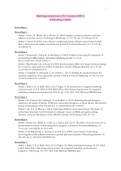Samenvatting
Complete samenvatting Marketing Communication and the Consumer
Samenvatting van de hoorcolleges en artikelen van het vak Marketing Communication and the Consumer, gegeven in de Master Communicatiewetenschap aan de VU Amsterdam. Bevat geen samenvatting van de gegeven guest lectures omdat dit niet van toepassing was voor het tentamen. Grotendeels Engels, maar so...
[Meer zien]




